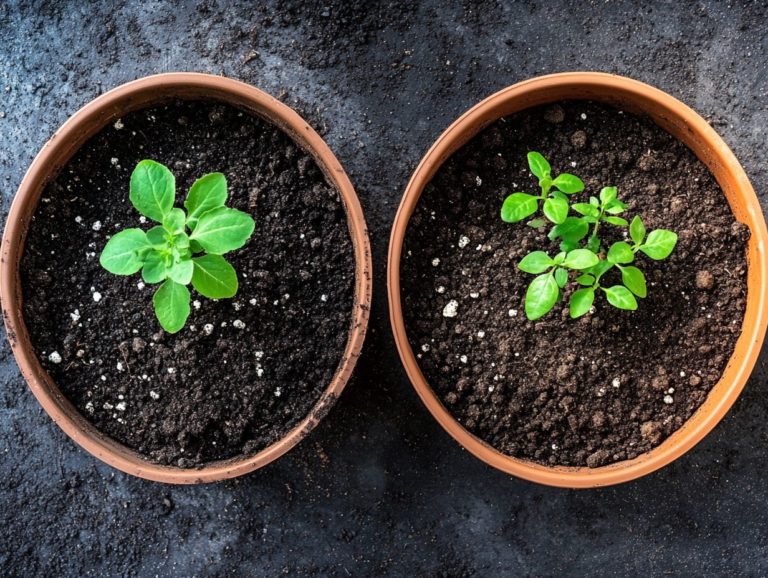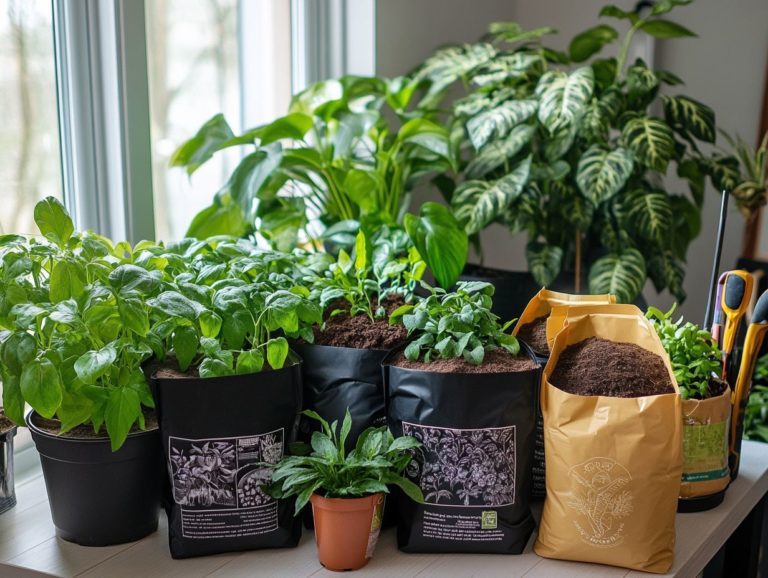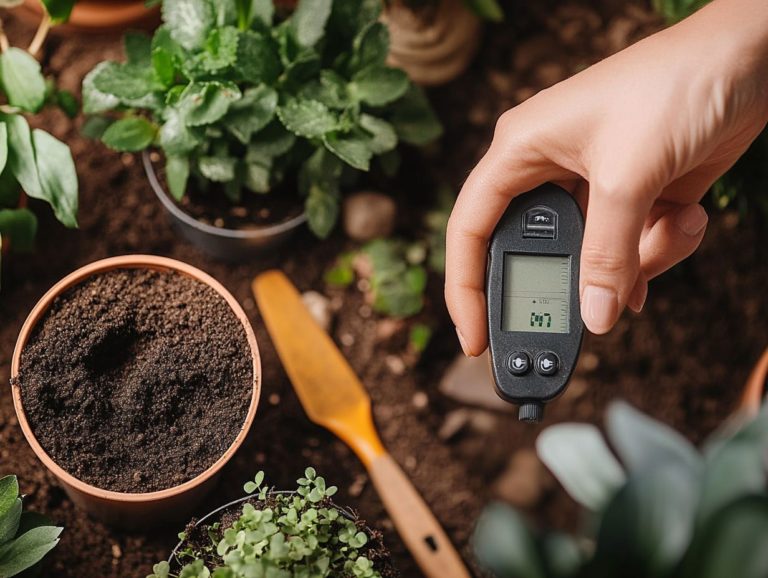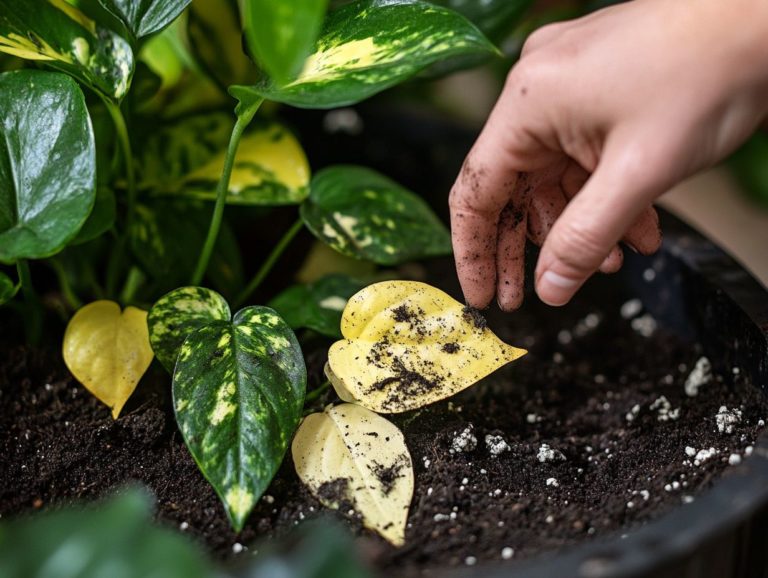How to Select the Best Indoor Plant Fertilizer
Understanding how to nourish your indoor plants is essential for promoting their growth and vitality. Let s dive into the secrets of indoor plant nutrition so you can enjoy a thriving indoor garden!
This article delves into the critical role fertilizers play in plant health, comparing organic and synthetic options, as well as slow-release and liquid varieties. You ll discover how to choose the right fertilizer tailored to your plant s specific needs, soil type, and optimal timing for application. We will also emphasize proper feeding techniques and methods for optimal plant performance.
We ll highlight common mistakes to avoid and share valuable tips for maintaining thriving plants. Prepare to cultivate your green thumb with confidence!
Contents
Key Takeaways:
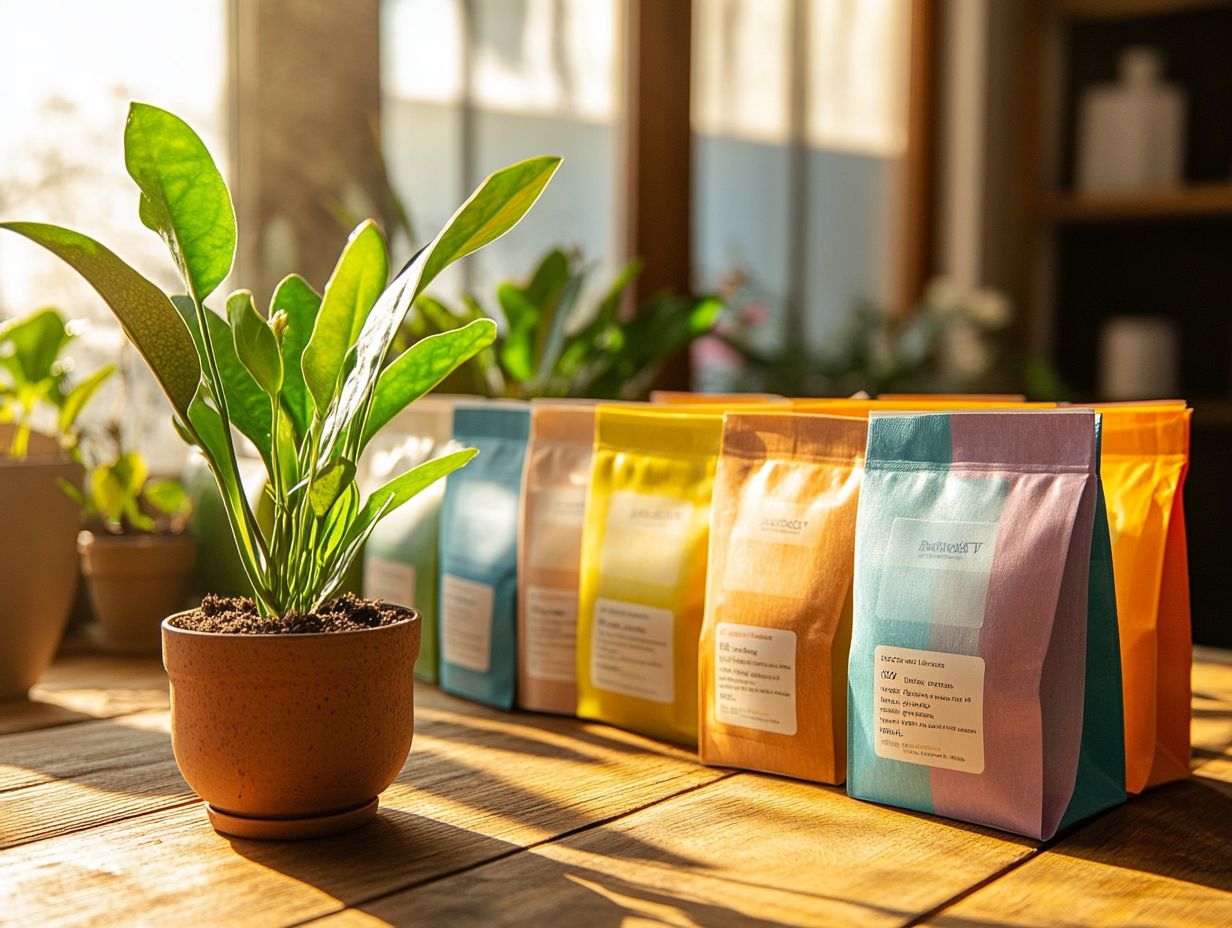
- Learn how fertilizers help plants grow and the differences between organic and synthetic options.
- Think about your plant s type, needs, and soil when picking the right fertilizer.
- Avoid common mistakes such as over-fertilization and using the wrong type of fertilizer, and maintain healthy plants through proper watering and sunlight.
Understanding Plant Nutrition
Understanding plant nutrition is essential for you to grow healthy indoor plants with lush leaves and vibrant flowers. Plants need key nutrients from macronutrients like nitrogen, phosphorus, and potassium, which are vital for your plants’ growth and overall performance.
Utilizing organic and water-soluble fertilizers is crucial in delivering these nutrients, ensuring your houseplants thrive in their indoor environment. For guidance on what fertilizer to use, check out what fertilizer should I use for indoor plants. Adopting the right fertilization regime supports photosynthesis, the process plants use to convert sunlight into energy and chlorophyll production, while maintaining balanced soil conditions, benefiting both roots and beneficial microbes.
With proper care and application techniques, you ll witness robust growth and enhanced plant health throughout all seasons.
The Role of Fertilizers in Plant Growth
Fertilizers play a pivotal role in your garden, supplying essential nutrients that are crucial for developing healthy foliage and vibrant flowers. These nutrients, especially macronutrients like nitrogen, phosphorus, and potassium, foster critical processes such as photosynthesis, root development, and flower production.
When you re deciding between organic options like compost or manure and water-soluble fertilizers, think about how each type will affect the health and growth rates of your plants. A balanced application of these nutrients not only promotes chlorophyll production, which is vital for that lush green color and energy conversion, but also enhances your plants’ resilience against diseases and pests. Ultimately, choosing the right fertilizer can make all the difference, ensuring your plants thrive beautifully throughout their growing seasons.
Types of Indoor Plant Fertilizers
Maintaining indoor plants requires a keen understanding of the different types of fertilizers to ensure effective application and optimal nutrient delivery. You ll find that fertilizers generally fall into two main categories: organic and synthetic. Each offers distinct advantages.
Organic fertilizers, often composed of natural ingredients, enhance soil health gradually, fostering a thriving environment for your plants. For the best results, consider using the best organic fertilizers for indoor plants. On the other hand, synthetic fertilizers deliver nutrients swiftly, making them a favored option for those fast-growing indoor varieties.
Organic vs. Synthetic Fertilizers
When you’re weighing the choice between organic and synthetic fertilizers for your houseplants, it’s essential to delve into their distinct properties and how they deliver nutrients.
Organic fertilizers, derived from natural sources, improve soil quality over time and stimulate microbial activity both crucial elements for thriving plants. On the other hand, synthetic fertilizers are designed for quick nutrient access, often leading to impressive, rapid growth. While the allure of instant results from synthetic options can be tempting, be aware that over-reliance on them might compromise soil health in the long run.
By grasping how each type affects not just growth rates but also environmental sustainability, you can make a well-informed decision that promotes both the vitality of your plants and the balance of the ecosystem.
Slow-release vs. Liquid Fertilizers
Choosing between slow-release and liquid fertilizers can greatly affect the nutrient supply and growth of your indoor plants.
Understanding the characteristics of these fertilizers is vital for any plant enthusiast. Slow-release options gradually dispense essential nutrients over time, ensuring a consistent supply that aligns with your plant’s growth cycle. This method significantly reduces the risk of nutrient burn, which is damage caused by too much fertilizer, a common issue with liquid fertilizers that deliver immediate boosts but often lead to rapid nutrient depletion.
For optimal results, slow-release fertilizers should be mixed into the soil before planting or sprinkled on top during repotting. If you prefer liquid fertilizers, dilute them according to the package instructions and apply during the active growth phase. To further enhance your indoor gardening knowledge, consider learning about the best time to fertilize indoor plants. This ensures your plants receive maximum benefits without being overwhelmed.
Factors to Consider When Choosing Fertilizers
When selecting fertilizers for indoor plants, consider several factors to ensure optimal nutrient delivery and maintain your plants’ health.
Plant Type and Nutrient Needs
Different houseplants have varying nutrient needs based on their species and growth stages.
Understanding these unique requirements is vital for a flourishing indoor garden. For instance, cacti usually need less fertilizer due to their adaptation to dry environments, while succulents can thrive on a balanced blend during their growing season. To better care for your plants, check out our guide on understanding fertilizer labels for indoor plants. Flowering species often require higher phosphorus levels to boost bloom production.
Keep an eye on your plants! If you see yellowing leaves or stagnant growth, it might be the right time to adjust your fertilizer application. Watch environmental factors like light and moisture to help you select the best nutrients for your green companions.
Soil Type and pH Balance
The type of soil and its pH balance play a key role in how well your indoor plants access nutrients from fertilizers.
Learning to assess soil types is essential for any plant enthusiast. You can conduct a simple pH test at home or send a sample to a local extension service for a thorough analysis. Generally, a soil pH range of 6 to 7 is best for most plants, as it allows for optimal nutrient absorption. Keep in mind that sandy soils may drain quickly but often lack essential nutrients, while clay soils retain moisture and can become compacted.
To address these challenges, amend your soil with organic matter, like compost, to enhance its texture and nutrient profile. This will optimize your plants’ health and the effectiveness of your fertilizers.
How to Properly Apply Fertilizer
Properly applying fertilizers is crucial for maximizing their benefits and promoting healthy growth in your indoor plants. By understanding each plant’s specific needs and applying fertilizers thoughtfully, you can create an environment where your greenery thrives.
Timing and Frequency
The timing and frequency of fertilizer application are critical for nurturing the growth and health of your indoor plants.
Understanding seasonal growth patterns directly influences when and how much fertilizer to apply. Typically, during the vibrant spring and summer months, when most indoor plants are active, these periods are crucial for supplying necessary nutrients. In contrast, as fall and winter approach, many species enter a dormant phase, significantly reducing their nutrient needs.
By fine-tuning your application frequency to align with your plants’ specific requirements and the environmental conditions like humidity and light exposure you can cultivate a flourishing indoor garden that embodies health and vitality.
Ready to choose the right fertilizer? Let s get your plants thriving!
Proper Techniques for Application
Utilizing proper techniques for fertilizer application enhances nutrient efficiency and fosters robust growth in your houseplants.
This means ensuring an even distribution of fertilizer across the soil surface, preventing certain areas from getting too much or too little, which can result in uneven growth.
Be aware of the risk of root burn, especially with concentrated products. Adhering to recommended dosages and guidelines is essential.
For liquid fertilizers, correct dilution is vital to maximize nutrient uptake without overwhelming your plants, ensuring a balanced approach to feeding.
Being mindful of environmental factors such as temperature, humidity, and soil moisture influences your application timing and method. This ultimately impacts the overall success of your fertilization efforts.
Common Mistakes to Avoid
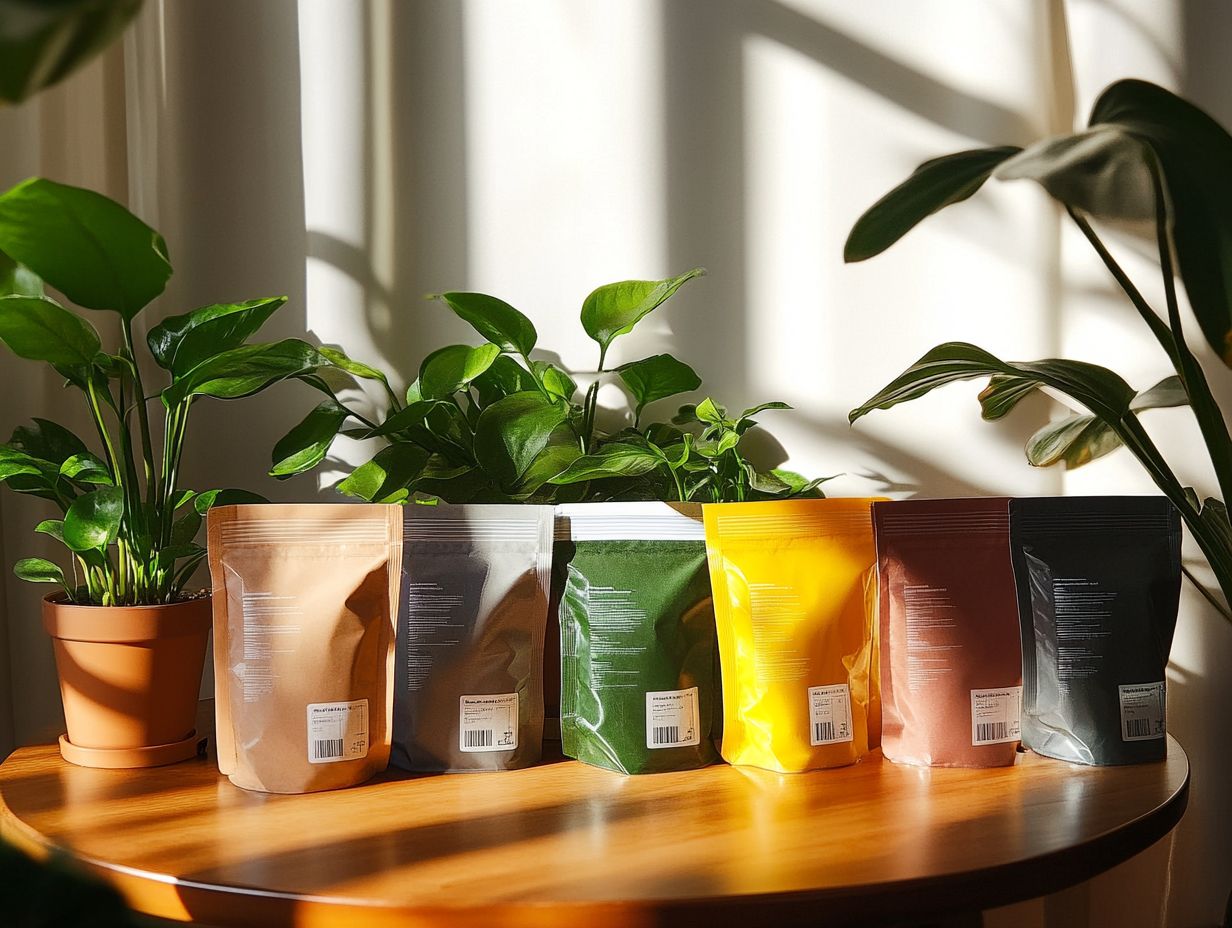
Avoiding common mistakes in fertilization is essential for keeping your houseplants healthy and vibrant. By practicing correct feeding and nutrient management, you can ensure they thrive beautifully in your care.
Over-fertilization and Its Consequences
Over-fertilization can seriously harm plant health, leading to issues like nutrient burn and stunted growth.
This occurs when excess fertilizers saturate the soil, making it hard to deliver essential nutrients effectively.
Consequently, the roots may struggle to absorb what they need for optimal growth, resulting in symptoms such as yellowing leaves, wilting, and lackluster flowering.
In the long run, this stress can sap the plant’s vigor, making it vulnerable to pests and diseases. To avoid these pitfalls, adhere to recommended application rates and monitor soil health closely.
If you find yourself dealing with over-fertilization, gently flush the soil with water to leach out excess nutrients. Alternatively, repotting the plant in fresh soil may promote a more robust recovery.
Using the Wrong Type of Fertilizer
Using the wrong type of fertilizer can lead to serious repercussions for specific plant types and hinder their growth.
Choosing inappropriate fertilizers can cause nutrient deficiencies or toxicities, ultimately impacting how well your plants thrive.
For example, a high-nitrogen fertilizer may encourage lush foliage for leafy greens, but it can hinder flowering and fruiting in plants such as tomatoes and peppers.
Understanding the unique nutrient requirements of different plants is crucial. This means matching fertilizers to their growth stages and specific needs. Acid-loving plants like azaleas flourish with formulations rich in sulfur, while cacti thrive on low-nitrogen options that support their drought-tolerant nature. For optimal results, consider using the top 10 fertilizers for thriving indoor plants.
By adopting a tailored approach to fertilization and considering factors like macronutrients, nitrogen, phosphorus, and potassium, you optimize nutrient delivery and enhance the overall vitality of your plants.
Tips for Maintaining Healthy Plants
Embrace a holistic approach and watch your indoor garden thrive! This includes precise watering, optimal sunlight exposure, and attentive care.
Each element plays a crucial role in fostering a thriving indoor garden, ensuring your plants remain healthy and flourishing.
Don’t wait! Start applying these techniques today for healthier, happier houseplants!
Proper Watering and Sunlight
Providing your indoor plants with the right amount of water and sunlight is key to their growth and vitality.
Each species has unique requirements, so understanding these needs is essential. For example, succulents grow well in bright, indirect sunlight and need infrequent watering. Allow the soil to dry out completely between waterings.
Tropical plants, like ferns and peace lilies, prefer consistently moist soil and indirect light. They’re a bit more forgiving on watering frequency.
To maintain the perfect balance, develop a fertilizer schedule that aligns with your light and watering routines. Using a slow-release fertilizer during the growing season ensures your plants receive the nutrients they need without being overwhelmed.
Frequently Asked Questions
What nutrients should I look for in an indoor plant fertilizer?
The essential nutrients your indoor plants need include nitrogen, phosphorus, and potassium, often noted as NPK on fertilizer packages. Calcium, magnesium, and sulfur are also important.
Which type of fertilizer is best for indoor plants?
The best type of fertilizer for indoor plants can vary. Liquid fertilizers are easier to apply and provide a quick nutrient boost, while granular fertilizers release nutrients over a longer period. Consider your plants’ needs when choosing a fertilizer type.
How do I determine the specific needs of my indoor plants?
The specific needs of your indoor plants can vary based on their species and growth stage. Research the requirements of each plant, including the ideal soil type and nutrients for healthy growth.
How often should I apply fertilizer to my indoor plants?
The frequency of fertilizer application varies depending on the type of fertilizer and your plants’ needs. Generally, applying fertilizer every 2-4 weeks during the growing season is recommended. Follow the instructions on the fertilizer package and watch for signs of over- or under-fertilization.
Can using the wrong indoor plant fertilizer harm my plants?
Yes, using the wrong type of fertilizer or too much can harm your plants. Some fertilizers may contain harmful chemicals or excessive nutrients that can burn or damage your plants. Always choose a suitable fertilizer for your specific plants and follow the application instructions.
Give your plants the love they deserve by selecting the right fertilizer and care techniques!



